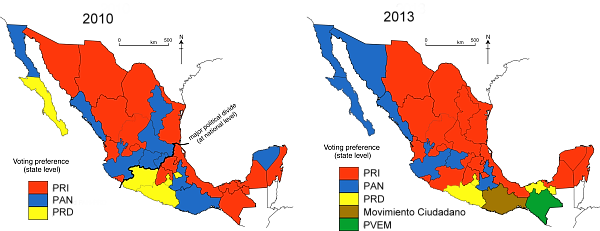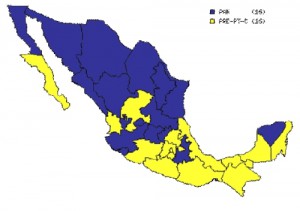Mexican governors are elected for single six-year terms; re-election is not permitted by the Mexican Constitution. The terms of governors in different states overlap; for example, seven of the 32 governors began their term of office in 2012.
The PRI (Partido Revolucionario Institucional, Institutional Revolutionary Party) currently holds 19 of the 32 governorships spread throughout Mexico (states colored red on map), except for the northwest and extreme south. On 1 March 2013, PRI will gain another governorship when Aristoteles Sandoval of PRI replaces the current PAN Governor of Jalisco. Although PRI Presidential candidate, Enrique Peña Nieto, easily won the Mexican Presidency in 2012, of seven new governors inaugurated in 2012, only three were from PRI.
Ex-President Calderón’s PAN (Partido Acción Nacional, National Action Party) is a distant second with seven governorships (blue on map); six after 1 March 2013. Four of the PAN governorships are in the northwest.
The PRD (Partido de la Revolución Democrática, Party of the Democratic Revolution) is third with four governorships (yellow on map). Three of the PRD governors took office in 2012. PRD has held the important governorship of the Mexico City Federal District since 1988.
The Governor of Oaxaca (brown on 2013 map) is from the Movimiento Ciudadano (Citizens’ Movement, formerly known as Convergencia or Convergence), which supported López Obrador in the 2006 presidential election. The Governor of Chiapas is from the PVEM (Partido Verde Ecologísta de México; Mexico’s Green Party; green on the 2013 map).
The north-south political divide that we have referred to in some previous posts, including the equivalent map for 2010 shown above, is no longer evident in the current pattern of state governorships.
Related posts:
- The preliminary results of Mexico’s 2012 presidential elections
- Mexico’s political system: the basics
- Relatively few changes following Mexico’s 2010 election
- Mexico’s North–South political divide
- Mexico’s north-south political divide persists, albeit with minor changes (Jul 2012)
- Mexico’s political system at the state and municipal levels (Apr 2012)


